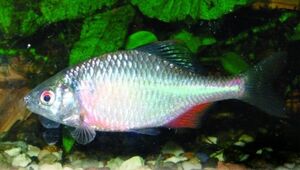(→Museum) |
(→Museum) |
||
| Line 13: | Line 13: | ||
The Bitterling is a fairly common [[river]] fish. It can be found all day between the months of [[December]] and [[February]]. It can be sold for 900 Bells. |
The Bitterling is a fairly common [[river]] fish. It can be found all day between the months of [[December]] and [[February]]. It can be sold for 900 Bells. |
||
==Museum== |
==Museum== |
||
| − | An information board in the [[aquarium]] will provide information about this fish. |
+ | An information board in the [[aquarium]] will provide information about this fish. |
| + | |||
| − | {{stub}} |
||
| + | "''These fish are so small, they can fit their entire body in the palm of your hand. During mating season, the male's belly turns a light orange in order to propery attract a mate. They live in rivers and lakes and deposit eggs in large bivalves where the eggs hatch and live for a while.''" |
||
==In real life== |
==In real life== |
||
Revision as of 13:28, 23 July 2013
- "I caught a bitterling! What's it so bitter about?"
Then please upload it!
The Bitterling is a fairly common river fish. It can be found all day between the months of December and February. It can be sold for 900 Bells.
Museum
An information board in the aquarium will provide information about this fish.
"These fish are so small, they can fit their entire body in the palm of your hand. During mating season, the male's belly turns a light orange in order to propery attract a mate. They live in rivers and lakes and deposit eggs in large bivalves where the eggs hatch and live for a while."
In real life

The Amur Bitterling, Rhodeus sericeus, is a small fish in the carp family. Bitterlings usually reside in areas with dense plant growth. They are a hardy fish and can survive in water that is not very well oxygenated. They grow to be 3-4in. long at most. The diet of a bitterling typically consists of plants and small insect larvae.
Bitterlings lay their eggs inside of mussels. Though it was long thought that it was a symbiotic relationship, it is in fact parasitic.